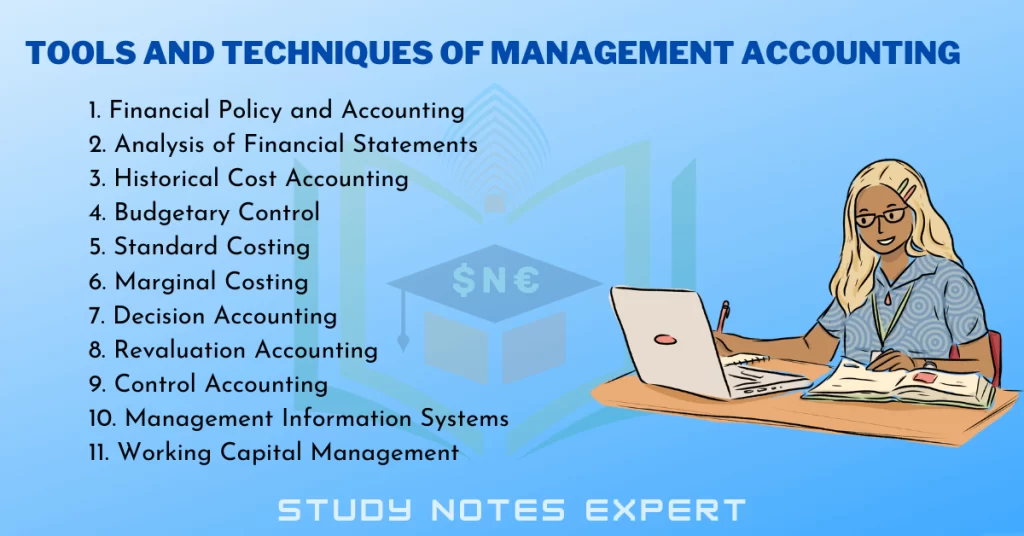Management accounting equipment isn’t a luxury but necessary within the current competitive commercial enterprise environment. They provide the specified quantitative and qualitative statistics to managers for strategic selection-making. The effectiveness of this equipment largely depends on the accuracy of the facts fed into them. Therefore, ensuring factual accuracy and integrity while using those tools for the most useful results is critical. A graphic depiction of various tools and techniques used by the system of Management Accounting is furnished below. Tools and techniques are very crucial if you want to manage accounting. In the next part, we will discuss the tools and techniques of management accounting:
Tools and Techniques of Management Accounting

The tools and techniques of management accounting are mentioned below:
1. Financial Policy and Accounting
An organization’s Capital structure reflects the sources of raising finance for business conduct. Depending upon the management policies, the finances may be raised through the ‘Equity Route’ or ‘Debt Route.’ Under the first route, there is an option for the ‘Issue of Share Capital’ or ‘Issue of Preference Share Capital.’ Similarly, various alternatives are available under the ‘Debt Route,’ like ‘Long Term Debts or Short Term Debts. Then there are options to issue ‘Bonds / ‘Debentures’ or ‘Institutional Borrowings. The choices are innumerable.
Further, the ratio of the ‘Debt Component’ and ‘Equity Component’ of an organization’s capital structure is also very important. In all such exercises about ‘Decision Making’ and ‘Policy Formulation,’ the ‘Management Accounting’ system provides the management with the necessary techniques to make their job smooth. Tax Planning is another crucial area where the “Management Accounting” system supports the management. A detailed study and analysis of various ‘Statutes’ and ‘Rule Books’ are undertaken by the ‘Management Accountant,’ and timely and suitable advice is rendered to the management. These tools of management accounting plays very crucial role in management.
2. Analysis of Financial Statements
Financial Statements, viz. “Profit & Loss Accounts & Balance Sheet’ or even “Funds Flow Statement’ & ‘Cash Flow Statements are rather technical and difficult to comprehend. They are subjected to rearrangement, proper classification, and analysis (including ratio analysis) by the Management Accountant’ and presented in such form and manner that they become simple, easily understandable, and “Ready to Use by the management for ‘Decision Making” and “Policy Formulation exercises.
3. Historical Cost Accounting
Under the “Historical Cost Accounting system,” the information regarding costing is recorded either on the actual transaction date or a subsequent date. A comparison between the ‘Actual Cost and the ‘Standard Cost (predetermined by the management) indicates the organization’s performance in this area. Historical Cost Accounting, though quite useful, has certain restrictions concerning its application.
4. Budgetary Control
The “Budgetary control” system helps prepare Budgets for all the Functional Departments of the organization based on past data and the department’s potential. The actual performance of the departments and individual employees is monitored on an ongoing basis regarding the targets fixed under the Budget. The entire process enables the management to control the affairs of different departments and their employees and prompt it for necessary action (including changes in its planning and policy).
5. Standard Costing
Under the system of “Standard Costing,” costs involved in each activity are pre-decided based on study and analysis of the prevailing internal and external circumstances. After determining standard costs in the above manner, the actual costs incurred later are compared with standard costs. Any deviation between the two is analyzed to ascertain the causes of such variance and initiate appropriate measures, ‘Standard Costing acts as an effective tool for
i) Cost Control
ii) Increasing overall organizational efficiency
iii) Management by Exception
6. Marginal Costing
The underlying principle of the ‘Marginal Costing’ system is that the cost also changes with the changes in the production volume. The cost Element of a product is bifurcated into “Fixed Cost” and “Marginal Cost.” The Fixed Cost of production remains constant irrespective of the production level. It means that even if a single product unit is produced, the minimum fixed cost would be incurred, remaining unchanged at a certain level after that. With the production of every additional unit, only the variable cost will be added.
7. Decision Accounting
One of the most important functions of the management of any organization is to make decisions. ‘Decision Making’ exercise involves:
i) Availability of data and multiple choices
ii) Pros and cons associated with each of those choices
iii) Deciding the best course of action, keeping in mind the interest and welfare of the organization.
The system of “Management Accounting” provides the management with the necessary inputs (mentioned above, along with the Financial Implications’, ‘Risks Involved. ‘Future Prospects, etc.) required for decision-making at their level, especially in respect of “Capital expenditure,’ ‘Expansion Diversification, etc.
8. Revaluation Accounting / Replacement Accounting
The management of any organization is entrusted with the time-consuming task of ensuring that its capital remains intact, i.e., there is no erosion of capital under any circumstances. The ‘Management Accountant’ is helpful to the management in performing the task; the computation of profits is carried out in such a manner that the ‘Capital’ remains unaffected, even when the inflationary forces are very strong. Replacement of ‘Fixed Assets’ is planned without putting undue strain on ‘Profitability’ and ‘Capital.’
According to Batty, “Revaluation accounting is used to denote the methods employed for overcoming the problems connected with fixed asset replacement in a period of rising prices.”
9. Control Accounting
Various tools and systems are a part of ‘Control Accounting, some of which are as follows:
i) Internal Audit
ii) Statutory Audit
iii) Concurrent Audit
iv) Variance Analysis Reports
v) Management Information Reports
10. Management Information Systems
With the advent of electronic devices and the growth of Information Technology of late, various steps involved in accounting, viz. recording, classifying data, and analysis, have become easy, convenient, and fast. Data flow through various management channels occurs very fast (some of them on ‘Real Time Basis?). “Decision Making Process at top levels of management and flow of information at lower levels of management in the form of instructions (about the further course of action) has also improved significantly.
11. Working Capital Management
The system of “Management Accounting uses this tool to efficiently manage ‘Working Capital. It includes handling of “Short Term Assets’ (cash, sundry debtors, inventories, etc.) and ‘Short Term Liabilities (sundry creditors, miscellaneous expenses, etc.). Any mismatch between them (Working Capital Gap) must be filled without losing time. The target is to reduce the time to convert “Raw Material’ into ‘Sales’ and ‘Sundry Debtors’ into ‘Cash.’
Conclusion
We have explained all the tools and techniques of management accounting. The tools and techniques of management accounting play a crucial role within the monetary decision-making system of a business enterprise. They are important for strategic planning, overall performance evaluation, and manipulation inside an employer. However, the software of those tools requires talent and judgment, necessitating constant refinement and adaptation to satisfy the specific needs of each enterprise.
The techniques, which include budgeting and forecasting, provide a roadmap for corporations to plan their future monetary selections. These gear help managers understand where the business enterprise is headed and make decisions that best align with those future projections. Variance evaluation, alternatively, facilitates assessing the performance of the business via evaluating the budgeted figures with the real figures.

